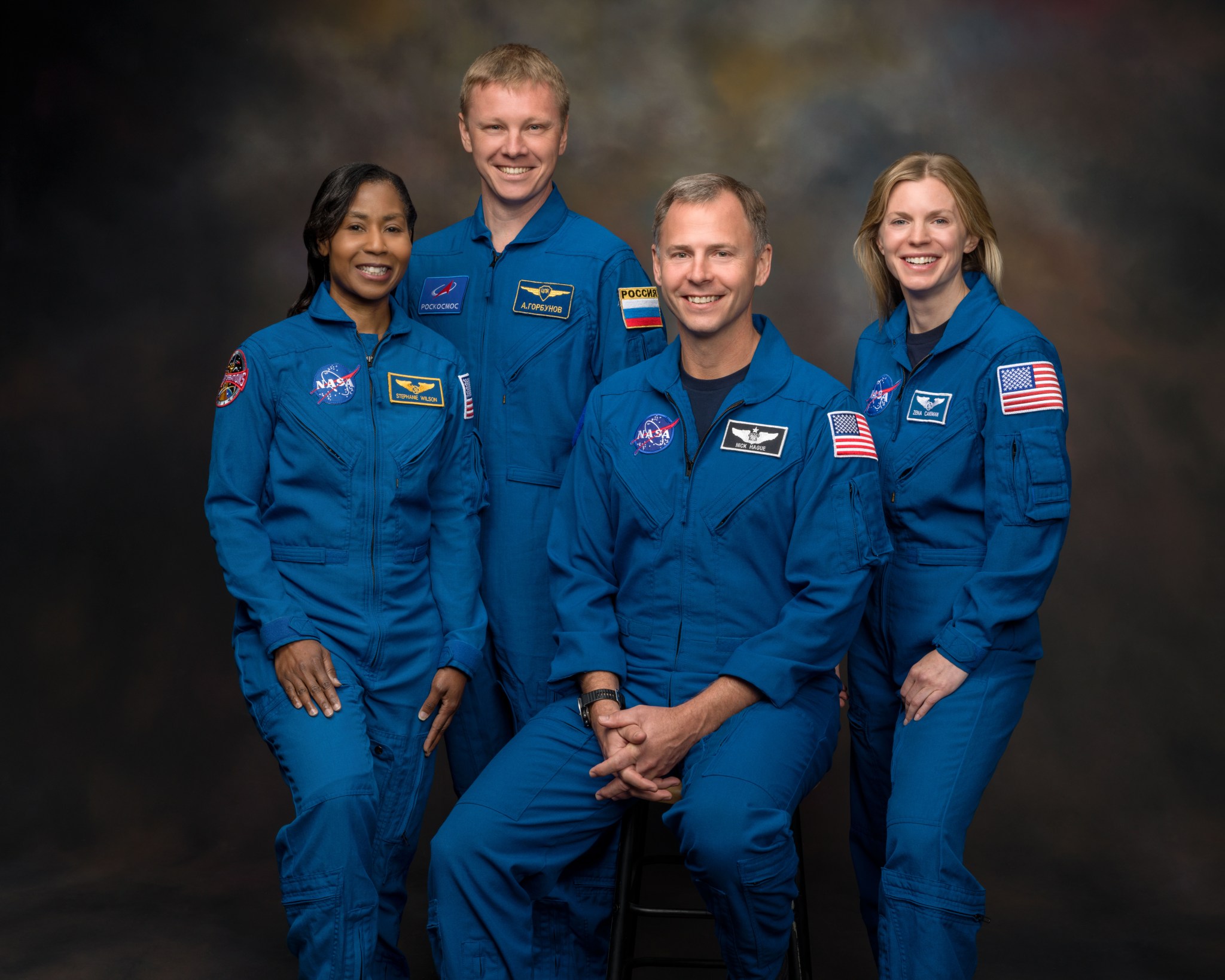NASA Sets Briefings for Crew-9 Mission
to Space Station
JUL 19, 2024 MEDIA ADVISORY M24-099 Official NASA’s SpaceX Crew-9 portraits with Zena Cardman, Nick Hague, Stephanie Wilson, and Aleksandr Gorbunov. Credit: NASA
NASA will host a pair of news conferences Friday, July 26, from the agency’s Johnson Space Center in Houston to highlight upcoming crew rotation missions to the International Space
Station.
NASA will host a mission overview news conference at 12 p.m. EDT and provide coverage on NASA+,
NASA Television, the NASA app, YouTube,
and the agency’s website. The news conference will cover NASA’s SpaceX Crew-9 mission to the microgravity laboratory and Expeditions 71 and 72.
NASA also will host a crew news conference at 2 p.m., and provide coverage on NASA+,
NASA Television, the NASA app, YouTube,
and the agency’s website, followed by individual astronaut interviews at 3 p.m. Learn how to stream
NASA TV through a variety of platforms, including social media.
The Crew-9 mission, targeted to launch in mid-August, will carry NASA astronauts Zena
Cardman, Nick Hague, Stephanie
Wilson, and cosmonaut Alexsandr Gorbunov of Roscosmos to the orbiting laboratory. A SpaceX Falcon 9 rocket will launch the crew aboard a Dragon spacecraft from Launch Complex 39A at NASA’s Kennedy Space Center in Florida on the company’s ninth crew
rotation mission for NASA.
These events will be the final media opportunity to speak to the Crew-9 astronauts before they travel to NASA Kennedy for launch. United States-based media seeking to attend in person
must contact the NASA Johnson newsroom no later than 5 p.m., Thursday, July 25, at 281-483-5111 or jsccommu@mail.nasa.gov. U.S. and international media interested in participating
by phone must contact NASA Johnson by 9:45 a.m. the day of the event.
U.S. or international media seeking remote interviews must submit requests to the NASA Johnson newsroom by 5 p.m., Thursday, July 25. A copy of NASA’s media
accreditation policy is online.
Briefing participants are as follows (all times Eastern and subject to change based on real-time operations):
12 p.m.: Mission Overview News. Conference
2 p.m.: Crew News Conference
3 p.m.: Crew Individual Interview Opportunities
The Crew-9 mission will be the first spaceflight for Cardman, who was selected as a NASA astronaut in 2017. The Williamsburg, Virginia, native holds a bachelor’s degree in Biology and
a master’s in Marine Sciences from the University of North Carolina at Chapel Hill. At the time of selection, she was a doctoral candidate in geosciences. Cardman’s research focused on geobiology and geochemical cycling in subsurface environments, from caves
to deep sea sediments. Since completing initial training, Cardman has supported real-time station operations and development for lunar surface exploration. Follow @zenanaut on
X and @zenanaut on
Instagram.
With 203 days logged in space, this will be Hague’s third launch and second mission to the orbiting laboratory. During his first launch in 2018, Hague and his crewmate, Roscosmos cosmonaut
Alexey Ovchinin, experienced a rocket booster failure, resulting in an in-flight launch abort and safe landing for their Soyuz MS-10 spacecraft. Five months later, Hague launched aboard Soyuz MS-12 and served as a flight engineer aboard the space station during
Expeditions 59 and 60. Hague conducted three spacewalks to upgrade space station power systems and install a docking adapter for commercial spacecraft. As an active-duty colonel in the U.S. Space Force, Hague completed a developmental rotation at the Department
of Defense in Washington, where he served as the USSF director of test and evaluation from 2020 to 2022. In August 2022, Hague resumed duties at NASA, working on the Boeing Starliner Program until this flight assignment. Follow @astrohague on
X and @astrohauge on
Instagram.
A veteran of three spaceflights aboard space shuttle Discovery, Wilson has spent 42 days in space. During her first mission, STS-121, in July 2006, she and her crewmates spent 13 days
in orbit. Wilson served as the robotic arm operator for spacecraft inspection, the installation of the “Leonardo” Multi-Purpose Logistics Module, and spacewalk support. In October 2007, Wilson and her STS-120 crewmates delivered the Harmony module to the station
and relocated a solar array. In April 2010, Wilson and her STS-131 crewmates completed another resupply mission to the orbiting complex, delivering a new ammonia tank for the station cooling system, new crew sleeping quarters, a window observation facility,
and a freezer for experiments. During nearly 30 years with NASA, Wilson served as the integration branch chief for NASA’s Astronaut Office, focusing on International Space Station systems and payload operations. She also completed a nine-month detail as the
acting chief of NASA’s Program and Project Integration Office at the agency’s Glenn Research Center in Cleveland. Follow @astro_stephanie on
X.
This will be Gorbunov’s first trip to space and the station. Born in Zheleznogorsk, Kursk region, Russia, he studied engineering with qualifications in spacecraft and upper stages from
the Moscow Aviation Institute. Gorbunov graduated from the military department with a specialty in operating and repairing aircraft, helicopters, and aircraft engines. Before being selected as a cosmonaut in 2018, he worked as an engineer for Rocket Space
Corporation Energia and supported cargo spacecraft launches from the Baikonur Cosmodrome.
Learn more about how NASA innovates for the benefit of humanity through NASA’s Commercial Crew Program at:
https://www.nasa.gov/commercialcrew
-end- |

